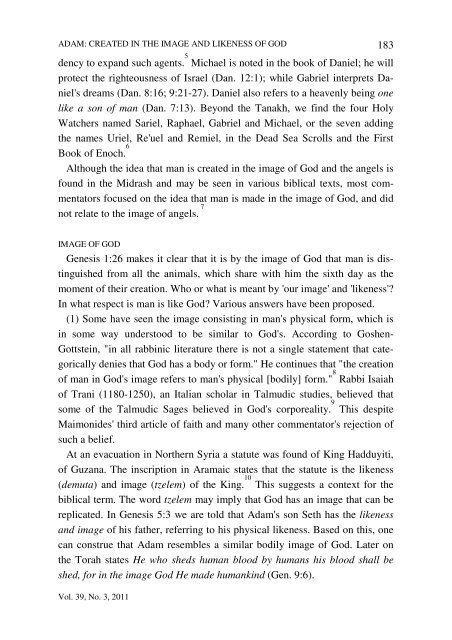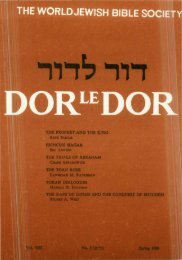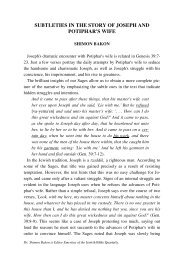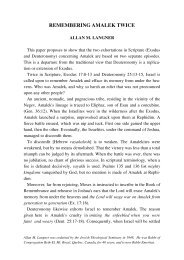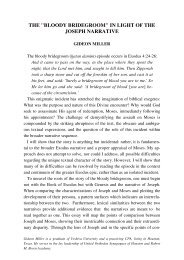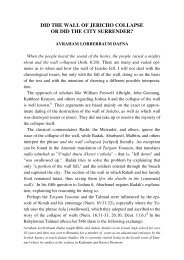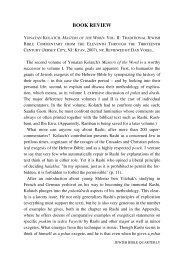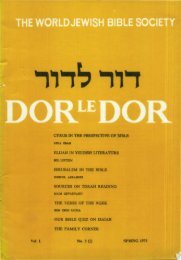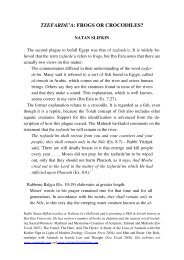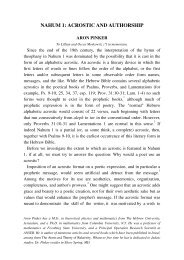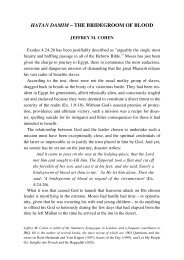Adam: Created in the Image and Likeness of God - Jewish Bible ...
Adam: Created in the Image and Likeness of God - Jewish Bible ...
Adam: Created in the Image and Likeness of God - Jewish Bible ...
You also want an ePaper? Increase the reach of your titles
YUMPU automatically turns print PDFs into web optimized ePapers that Google loves.
ADAM: CREATED IN THE IMAGE AND LIKENESS OF GOD<br />
183<br />
dency to exp<strong>and</strong> such agents. 5<br />
Michael is noted <strong>in</strong> <strong>the</strong> book <strong>of</strong> Daniel; he will<br />
protect <strong>the</strong> righteousness <strong>of</strong> Israel (Dan. 12:1); while Gabriel <strong>in</strong>terprets Daniel's<br />
dreams (Dan. 8:16; 9:21-27). Daniel also refers to a heavenly be<strong>in</strong>g one<br />
like a son <strong>of</strong> man (Dan. 7:13). Beyond <strong>the</strong> Tanakh, we f<strong>in</strong>d <strong>the</strong> four Holy<br />
Watchers named Sariel, Raphael, Gabriel <strong>and</strong> Michael, or <strong>the</strong> seven add<strong>in</strong>g<br />
<strong>the</strong> names Uriel, Re'uel <strong>and</strong> Remiel, <strong>in</strong> <strong>the</strong> Dead Sea Scrolls <strong>and</strong> <strong>the</strong> First<br />
Book <strong>of</strong> Enoch. 6<br />
Although <strong>the</strong> idea that man is created <strong>in</strong> <strong>the</strong> image <strong>of</strong> <strong>God</strong> <strong>and</strong> <strong>the</strong> angels is<br />
found <strong>in</strong> <strong>the</strong> Midrash <strong>and</strong> may be seen <strong>in</strong> various biblical texts, most commentators<br />
focused on <strong>the</strong> idea that man is made <strong>in</strong> <strong>the</strong> image <strong>of</strong> <strong>God</strong>, <strong>and</strong> did<br />
not relate to <strong>the</strong> image <strong>of</strong> angels. 7<br />
IMAGE OF GOD<br />
Genesis 1:26 makes it clear that it is by <strong>the</strong> image <strong>of</strong> <strong>God</strong> that man is dist<strong>in</strong>guished<br />
from all <strong>the</strong> animals, which share with him <strong>the</strong> sixth day as <strong>the</strong><br />
moment <strong>of</strong> <strong>the</strong>ir creation. Who or what is meant by 'our image' <strong>and</strong> 'likeness'?<br />
In what respect is man is like <strong>God</strong>? Various answers have been proposed.<br />
(1) Some have seen <strong>the</strong> image consist<strong>in</strong>g <strong>in</strong> man's physical form, which is<br />
<strong>in</strong> some way understood to be similar to <strong>God</strong>'s. Accord<strong>in</strong>g to Goshen-<br />
Gottste<strong>in</strong>, "<strong>in</strong> all rabb<strong>in</strong>ic literature <strong>the</strong>re is not a s<strong>in</strong>gle statement that categorically<br />
denies that <strong>God</strong> has a body or form." He cont<strong>in</strong>ues that "<strong>the</strong> creation<br />
<strong>of</strong> man <strong>in</strong> <strong>God</strong>'s image refers to man's physical [bodily] form." 8<br />
Rabbi Isaiah<br />
<strong>of</strong> Trani (1180-1250), an Italian scholar <strong>in</strong> Talmudic studies, believed that<br />
some <strong>of</strong> <strong>the</strong> Talmudic Sages believed <strong>in</strong> <strong>God</strong>'s corporeality. 9<br />
This despite<br />
Maimonides' third article <strong>of</strong> faith <strong>and</strong> many o<strong>the</strong>r commentator's rejection <strong>of</strong><br />
such a belief.<br />
At an evacuation <strong>in</strong> Nor<strong>the</strong>rn Syria a statute was found <strong>of</strong> K<strong>in</strong>g Hadduyiti,<br />
<strong>of</strong> Guzana. The <strong>in</strong>scription <strong>in</strong> Aramaic states that <strong>the</strong> statute is <strong>the</strong> likeness<br />
(demuta) <strong>and</strong> image (tzelem) <strong>of</strong> <strong>the</strong> K<strong>in</strong>g. 10<br />
This suggests a context for <strong>the</strong><br />
biblical term. The word tzelem may imply that <strong>God</strong> has an image that can be<br />
replicated. In Genesis 5:3 we are told that <strong>Adam</strong>'s son Seth has <strong>the</strong> likeness<br />
<strong>and</strong> image <strong>of</strong> his fa<strong>the</strong>r, referr<strong>in</strong>g to his physical likeness. Based on this, one<br />
can construe that <strong>Adam</strong> resembles a similar bodily image <strong>of</strong> <strong>God</strong>. Later on<br />
<strong>the</strong> Torah states He who sheds human blood by humans his blood shall be<br />
shed, for <strong>in</strong> <strong>the</strong> image <strong>God</strong> He made humank<strong>in</strong>d (Gen. 9:6).<br />
Vol. 39, No. 3, 2011


